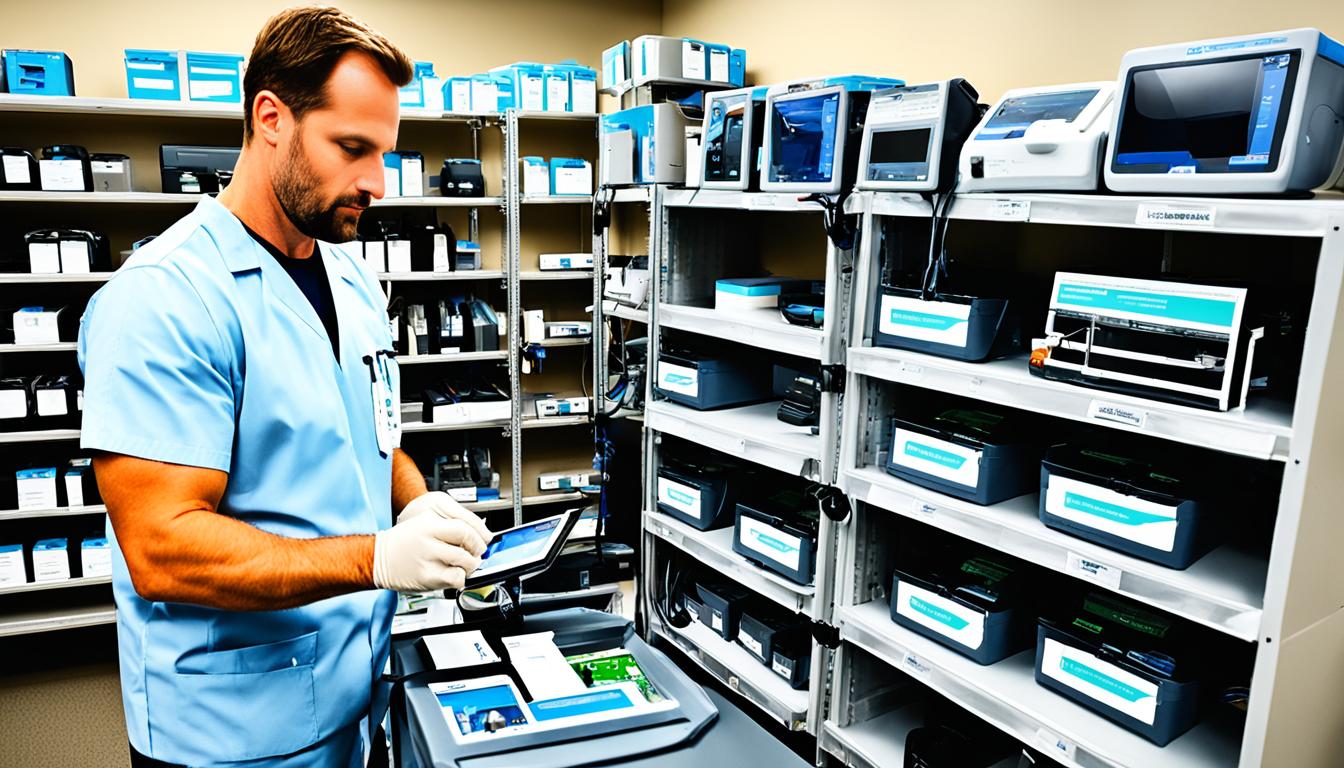Did you know 100% compliance isn’t just ideal—it’s mandatory? Facilities that fall short risk losing accreditation and face threats to patient care. With unannounced audits becoming standard, healthcare teams need solutions that turn regulatory demands into seamless workflows.
Advanced management systems now automate critical tasks like tracking repairs and validating safety checks. For example, platforms like Crothall Healthcare’s teamCHAMPS use 24/7 monitoring to catch issues before they escalate. This isn’t just about avoiding fines—it’s about keeping devices ready for life-saving work.
When tools fail, delays in care can follow. Reliable systems ensure uptime by scheduling preventive tasks and storing digital records securely. These features also simplify audits, since inspectors demand flawless documentation to prove adherence to standards like ISO 13485.
Ultimately, compliance isn’t a checkbox. It’s the backbone of trust in healthcare. By blending automation with rigorous oversight, organizations protect both patients and their reputations.

Key Takeaways
- Mandatory compliance: Falling short risks accreditation and patient safety.
- Automation advantage: Systems streamline audits and reduce human error.
- Early issue detection: Continuous monitoring prevents equipment failures.
- Documentation matters: Secure digital records meet strict regulatory standards.
- Patient-first focus: Reliable tools ensure uninterrupted care delivery.
The Importance of Compliance in Healthcare Operations
Navigating the complex landscape of healthcare regulations isn’t just about avoiding penalties—it’s about building a foundation for safe, efficient care. Teams juggle everything from sterilization protocols to emergency response plans, where even minor oversights can spiral into critical risks.
Understanding Regulatory Requirements
Agencies like the Joint Commission and DNV set rigorous benchmarks for operational standards. For instance, OSHA mandates regular hazard assessments, while HIPAA demands airtight data protection. These rules aren’t suggestions—they’re non-negotiable shields against legal and financial fallout.
Modern tools simplify adherence by automating documentation and audit trails. Take Crothall’s approach: their systems map workflows to ISO 13485 standards, ensuring every task aligns with survey-ready protocols. This proactive stance turns compliance from a chore into a strategic advantage.
Benefits of Staying Compliant for Patient Safety
When teams prioritize regulatory alignment, they create safer environments. Properly maintained devices reduce infection risks, while secure information flow prevents diagnostic errors. One study showed facilities using PSQIA frameworks cut incident rates by 37% within a year.
Streamlined work processes also free staff to focus on care quality. Automated alerts flag overdue inspections, and centralized records let inspectors verify adherence in minutes. It’s how leading hospitals maintain trust while keeping lifesaving tools operational around the clock.
Preventive Maintenance: Key to Maximizing Asset Longevity
What if every piece of critical gear could outlast its expected lifespan? Proactive upkeep strategies make this possible by turning routine checks into powerful safeguards. Leading hospitals using platforms like eMaint schedule inspections based on real usage data—not arbitrary timelines—to catch wear patterns early.

Early Issue Detection and Proactive Planning
Imagine spotting a failing pump bearing weeks before it seizes. Systems with predictive analytics flag anomalies during vibration tests or temperature scans. This approach slashes emergency repairs by 42% in facilities adopting PDCA (Plan-Do-Check-Act) models, according to industry studies.
Teams using automated alerts resolve minor glitches during scheduled downtime. For example, replacing worn gaskets in imaging devices during off-hours prevents mid-procedure failures. It’s like changing your car’s oil before the engine light blinks.
Reducing Downtime and Redundancies
Unplanned outages cost U.S. healthcare over $12 billion annually. Structured processes eliminate this waste. One Midwest clinic cut MRI idle time by 63% after aligning lubrication schedules with manufacturer guidelines.
Digital checklists ensure technicians follow best practices every time. Centralized records also help managers spot trends—like which assets need more frequent attention. This data-driven method extends device usability while freeing staff from repetitive paperwork.
Leveraging Medical Equipment Maintenance Software for Compliance Excellence
How do top healthcare providers turn regulatory hurdles into operational strengths? By adopting tools that transform complex requirements into actionable workflows. Modern solutions bridge the gap between industry standards and daily operations, ensuring teams stay audit-ready without drowning in paperwork.
Streamlined Compliance Reporting and Monitoring
Automated systems like teamCHAMPS cut reporting time by 80% in some facilities. Their 24/7 dashboards track everything from calibration logs to safety validations, flagging gaps before auditors spot them. One Midwest hospital reduced corrective actions by 62% after switching to real-time tracking.
These platforms generate reports with one click, replacing manual spreadsheets prone to errors. Custom alerts notify staff about expiring certifications or overdue inspections. Mobile access lets technicians update records on-site, keeping data current across departments.
Integration with existing management software creates a single source of truth. For example, linking inventory systems ensures parts used in repairs meet OEM specifications—a common audit checkpoint. This seamless approach builds trust with inspectors while freeing teams to focus on patient care.
Streamlining Work Orders and Maintenance Management
When a critical device falters, every second counts—but paperwork shouldn’t slow the response. Efficiently managing work orders ensures staff address issues swiftly, keeping care delivery uninterrupted. Facilities using platforms like Crothall’s teamCHAMPS resolve urgent requests 40% faster by digitizing request forms and auto-prioritizing tasks.
Automating Task Assignments and Work Order Tracking
Automation transforms how teams handle repairs. Systems instantly route orders to available technicians based on location and expertise. For example, eMaint’s mobile app lets staff update task statuses on-site, cutting approval delays by half. Real-time dashboards show which work orders need attention, preventing overlooked requests.
Centralized tracking reduces redundancies. One Midwest hospital slashed equipment idle time by 58% after adopting a unified platform. Managers now monitor progress across departments, while automated alerts flag overdue tasks. This visibility helps teams collaborate better—like sharing repair notes or reserving parts ahead of time.
Digital tools also minimize manual errors. Integrated checklists ensure technicians follow safety protocols, and cloud-based records stay audit-ready. By streamlining maintenance management, healthcare providers boost uptime and focus resources where they matter most: patient care.
Optimizing Data Analytics and Reporting Capabilities
What if you could predict device issues before they disrupt patient care? Modern platforms transform raw numbers into strategic roadmaps. Take teamCHAMPS’ multi-level dashboards—they let teams monitor corrective actions, preventive schedules, and predictive trends in one view.
Real-Time Dashboards for Asset Visibility
Instant updates erase guesswork. At Mayo Clinic, predictive analytics slashed unexpected failures by 72% through live data streams. Their dashboards show device performance metrics alongside maintenance histories, helping technicians spot anomalies during routine checks.
These tools also simplify compliance. When inspectors request reports, managers export filtered datasets in seconds. No more scrambling through file cabinets—critical information stays organized and accessible.
Actionable Insights for Informed Decision-Making
Numbers mean little without context. Cleveland Clinic boosted patient satisfaction by 31% by comparing service trends across departments. Their teams now adjust schedules based on peak usage patterns revealed through management analytics.
Integrated platforms flag underused assets, too. One hospital reallocated 15 ventilators after discovering inconsistent utilization rates. This data-driven approach ensures resources match actual needs—not assumptions.
Enhancing Patient Safety with Automated Compliance Tools
Did you know 43.8% of device-related incidents stem from preventable failures? Modern systems tackle this by turning compliance into a safety net. They automate critical checks while letting teams focus on what matters—delivering uninterrupted care.

Minimizing Compliance Risks with Proactive Alerts
Real-time monitoring tools act like digital guardians. They flag calibration drifts in ventilators or overdue inspections for infusion pumps before issues arise. One health network reduced alert fatigue by 54% using smart filters that prioritize urgent maintenance needs.
These systems empower staff through mobile notifications. When a surgical tool nears its service deadline, technicians receive instant updates. This approach helped a Texas hospital cut response times by 40% during emergency repairs.
The results speak volumes. Facilities using automated services report 31% fewer equipment-related delays in treatment. By reducing manual tracking, teams spend more time addressing root causes rather than paperwork.
Ultimately, safer care starts with prevention. Automated compliance tools don’t just meet standards—they create environments where devices support healing rather than hinder it. Less downtime means more lives protected daily.
Integrating Technology to Meet Regulatory Standards
How can hospitals stay ahead of ever-changing regulations while keeping operations smooth? The answer lies in smart tech partnerships. Modern platforms now connect with RFID scanners, IoT sensors, and existing management systems to create unified compliance ecosystems.
Advanced Software Integrations with Third-Party Tools
Crothall’s equipREADY program demonstrates this power. By syncing with RTLS tags, it pinpoints device locations across facilities in real time. This integration slashes search times during audits and ensures proper sterilization cycles for mobile gear.
Healthcare CMMS solutions like eMaint take it further. Their customizable dashboards merge with EHRs and supply chain tracking tools. When a ventilator needs parts, the system checks inventory levels and auto-orders FDA-approved components—no manual cross-referencing needed.
These connections also future-proof operations. teamCHAMPS users report 55% faster audit prep since data flows between departments seamlessly. Inspectors see validated calibration records, repair histories, and staff certifications without digging through disjointed files.
The result? Equipment maintenance becomes proactive rather than reactive. One Midwest hospital cut compliance-related downtime by 68% after linking their CMMS to building sensors. Now, temperature-sensitive devices trigger alerts before environments drift out of spec.
By weaving tech partnerships into daily workflows, healthcare teams turn regulatory hurdles into strategic wins. It’s not just about checking boxes—it’s about building systems that adapt as standards evolve.
Conclusion
What separates leading healthcare facilities from those struggling with audits? A commitment to turning compliance into competitive advantage. Robust management systems empower teams to meet regulations while improving care quality—proving these goals aren’t mutually exclusive.
Proactive strategies like predictive analytics and automated alerts transform how teams handle work orders. These tools cut response times while ensuring devices stay operational. With real-time tracking, organizations reduce risks and keep resources focused where they matter most.
The right solution also simplifies complex standards. Platforms aligning with HIPAA and FDA requirements help hospitals pass inspections effortlessly. Centralized records and mobile access let staff verify compliance during routine checks—not just audit week.
Ready to upgrade your approach? Explore tailored healthcare CMMS options offering free demos. Partnering with experts ensures your facility stays ahead of evolving industry demands while safeguarding patient trust. After all, reliable care starts with systems built to last.
See how FieldAx can transform your Field Operations.
Try it today! Book Demo
You are one click away from your customized FieldAx Demo!
FAQ
How does compliance-focused software improve healthcare operations?
It ensures adherence to strict regulatory standards like Joint Commission guidelines and FDA requirements. Automated tracking reduces manual errors, streamlines audits, and prioritizes patient safety by maintaining equipment reliability.
What role does preventive maintenance play in extending asset lifecycles?
Regular inspections and proactive scheduling help identify wear or malfunctions early. This minimizes unexpected breakdowns, reduces costly repairs, and ensures devices operate at peak performance for longer periods.
Can maintenance platforms integrate with existing hospital systems?
Yes. Leading solutions offer APIs to connect with EHRs, inventory databases, and facility management tools. This creates a unified ecosystem for real-time data sharing, improving cross-team collaboration and compliance reporting.
How do automated work order systems benefit clinical teams?
Instant task assignments and priority-based routing ensure urgent repairs get addressed first. Technicians receive mobile alerts with repair histories, reducing resolution times and keeping critical devices operational.
What reporting features support compliance audits?
Customizable dashboards track certification expirations, service histories, and safety checks. Automated reports generate audit-ready documentation, showcasing adherence to standards like HIPAA or ISO 13485 during inspections.
How does real-time data improve decision-making for facilities?
Analytics identify underperforming assets, maintenance trends, and budget impacts. Managers use these insights to optimize resource allocation, justify upgrades, and prevent compliance gaps before they affect patient care.
Why are proactive alerts vital for minimizing compliance risks?
Automated notifications for overdue calibrations or part recalls enable swift action. This prevents regulatory penalties and ensures devices meet accuracy standards required for safe diagnostics and treatment.
Can healthcare CMMS tools manage multi-site inventory?
Advanced platforms centralize asset databases across locations. Teams track spare parts, monitor usage patterns, and automate reorder triggers—ensuring critical components are always available without overstocking.
Author Bio
Co-Founder & CMO at Merfantz Technologies Pvt Ltd | Marketing Manager for FieldAx Field Service Software | Salesforce All-Star Ranger and Community Contributor | Salesforce Content Creation for Knowledge Sharing






